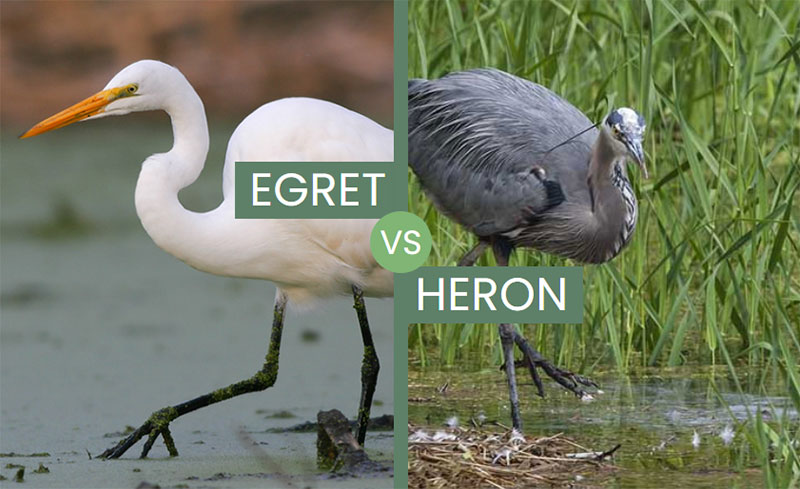Egret vs heron – both have beautiful long necks, and both often forage in shallow waters. At first sight, not so much would set them apart.
So, how are egrets and herons so similar? What’s the catch?
It may shock you to learn that there is no real scientific difference between egrets and herons. The biology of these two groups is notably similar. A few physical details could be deemed distinctive but can’t be applied to all species.
Could we conclude that Egrets are just smaller and more elegant Herons, with some showy feathering to spice things up in the breeding season?
Let’s dive into more detail on that.
On this page
Egret vs Heron Classification
The family Ardeidae (Herons) contains 70 species of birds we commonly call herons, egrets, and bitterns. Among others, there are two notable large genera, Egretta and Ardea, whose members we often call ‘Egrets’ and ‘Herons.’
Related: Bird families & classifications
Here is a very generalized rule on how to tell them apart.
‘True’ Herons – gen. Ardea
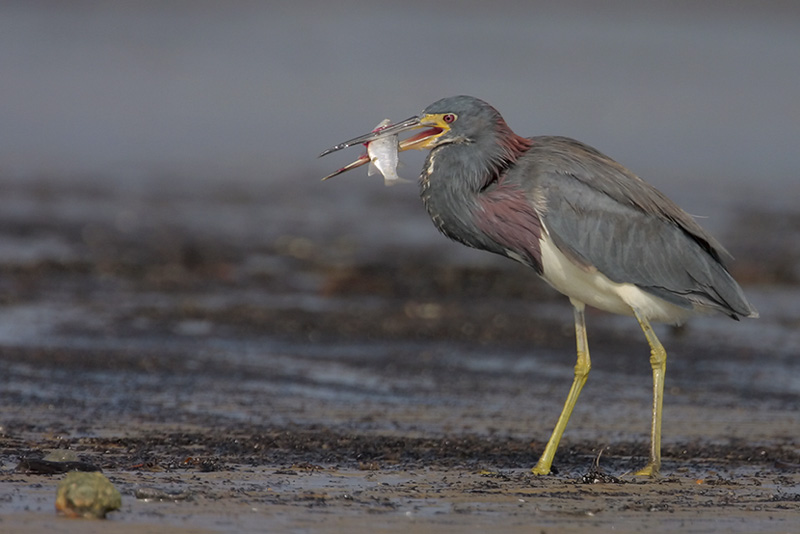
Tricolored Heron
Most birds we commonly call Herons belong to the genus Ardea. These include:
- Grey Heron (Ardea cinerea)
- Great Blue Heron (Ardea herodias)
- Pacific Heron (Ardea pacifica)
- Goliath Heron (Ardea goliath)
As you see, these species are indeed commonly called ‘herons.’
However, there are exceptions. The Great Egret is nevertheless in the Ardea genus, scientifically named Ardea alba (It’s a white heron, people! But nobody calls it that).
There are also ‘herons’ belonging to other genera – for example, the (Black-Crowned) Night Heron (Nycticorax nycticorax) or the Tiger Heron (Tigrisoma lineatum). Ironically, Tiger Herons are less related to ‘true’ herons than egrets.
Egrets – gen. Egretta
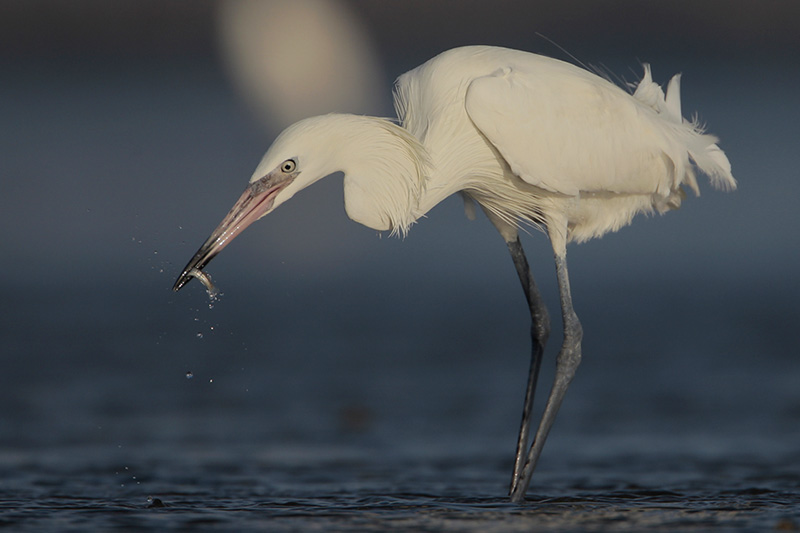
Reddish Egret (white morph)
Not surprisingly, most birds we call egrets belong to the family Egretta. These include:
- Little Egret (Egretta garzetta)
- Reddish Egret (Egretta rufescens)
- Snowy Egret (Egretta thula)
- Chinese Egret (Egretta eulophotes)
Still, there are exceptions in this group as well. Egretta caerulea has a small body size typical of egrets but is still commonly called the Little Blue Heron (in defense of that common name, the Little Blue Heron really does look like a miniature ‘true’ heron).
Also, there are egrets in other, separate genera – like the Cattle Egret (Bubulcus ibis).
Despite the tiny details that might (or might not) set them apart, egrets and herons have similar build and lifestyles – and we’re about to explore them.
Egret vs Heron – Body & Shape
Both herons and egrets are elegant but strong birds with large, long, spear-like bills, elongated necks, and long legs. Herons tend to be more robust than egrets.
Their bodies are an adaptation to their lifestyle, particularly feeding. The long legs help them walk through water and aquatic vegetation slowly and discretely while stalking their prey. Likewise, the long necks and bills help them get the usually unsuspecting prey in a striking motion.

Herons look fairly similar to egrets, but they are usually stockier
The sleek outline is also ideal for hiding. Herons and egrets – but especially herons – will often remain camouflaged and motionless while waiting for the prey to make the mistake of getting close, or while waiting for danger to pass.
Interesting fact: The large majority of herons and egrets have a long, harpoon-like bill, whether thin or thick. However, all families have an oddball, and this one is a nocturnal creature from the mangrove swamps of Mexico, Brazil, and Peru. It is called the Boat-billed Heron or simply the Boatbill. The Boatbill has a strange, short, stubby bill that you could vaguely describe as ‘boat-shaped.’
Size
Both herons and egrets are medium-to-large birds; the true herons (Ardea) are usually larger, so the size is another distinction between them. Still, the rule can’t be universally applied.
As its name discretely suggests, the biggest member of the family is the Goliath Heron. Native to Africa, it measures 1.5 meters in height and with a wingspan of more than two meters.
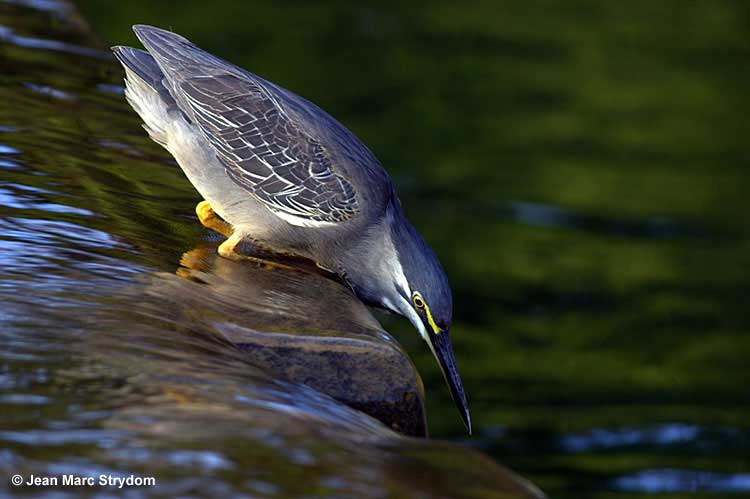
A Green Heron looking closely at its prey
The smallest egret is the delicate-looking (again, the name will surprise you) Little Egret, standing at 55-65 cm and with an 88-104 cm wingspan.
However, the Little Egret is not the smallest member of the entire heron family – the title goes to the Dwarf Bittern, measuring only 25–30 cm.
Flight and Speed
Herons exhibit a slow, steady flight, with characteristically retracted necks – tucked in an S-shape while airborne.
The neck retraction in flight is a feature that can help you distinguish herons and egrets (even from afar) from other long-necked aquatic birds – cranes, storks, spoonbills, and flamingos – which all fly with their necks extended.
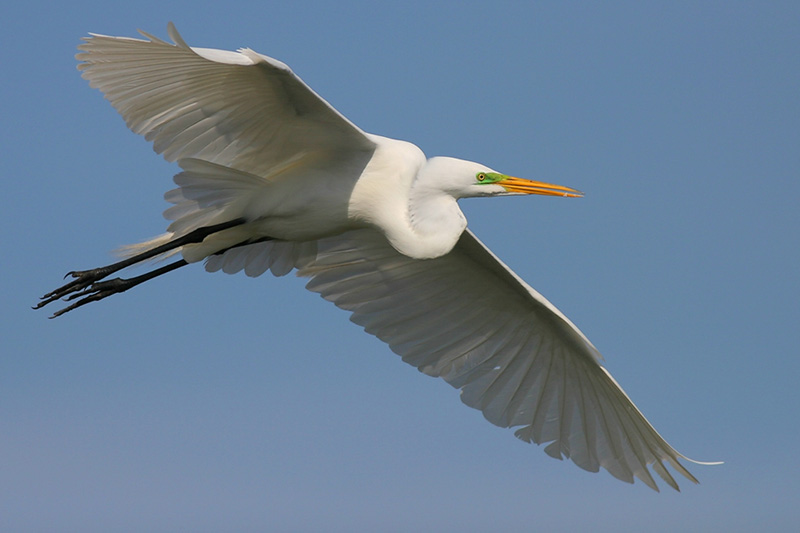
The S-shape is mainly seen during flight. Keep an eye on their legs, too.
Positioning the neck in the S-shape helps these large and lanky birds maintain optimal balance while flying.
The position is made possible by the modified sixth cervical vertebra. Besides improving flight aerodynamics, the modification allows herons to shoot their heads forward at high speed when fishing.
As for the flight speed, herons never seem to be in much of a hurry. However, the large wingspan of stockier species helps them reach impressive speeds. The Great Blue Heron can fly at 55 kilometers per hour.
Age and Lifespan
Herons and egrets are relatively long-lived birds, with an average lifespan of 15-22 years, according to various sources.
However, a heron may hope to live for a decade or two if it lives through the deadly first year.
First-year mortality for Great Egrets is a whopping 76 percent, and adult mortality is roughly 26 percent. Such high juvenile mortality is due to the tricky transition from parental care to adult hunting and feeding, as well as due to the migration risks.
If the young birds make it to their second birthday, the annual risk of death starts to decline.
As for record-holders, one of the oldest herons in the world is a wild Great Blue Heron that is at least 24 and a half years old as of 2023.
Egret vs Heron Diet
Both herons and egrets are predators, mainly hunting aquatic prey in still, shallow waters. Their diets consist of fish, amphibians, reptiles, crustaceans, mollusks, large insects, and other small animals they encounter in their aquatic habitats.
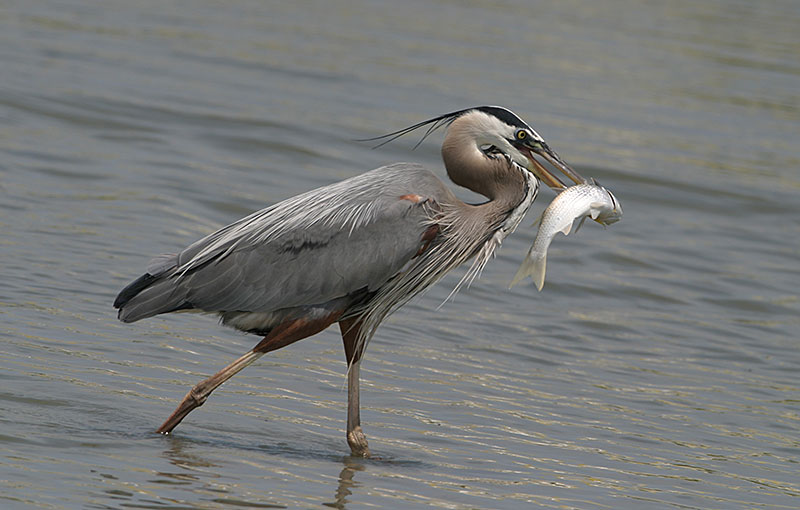
Egrets and herons have similar diets and hunting styles.
The larger the heron species, the larger the prey they try to tackle. However, their skill is sometimes a curse. Despite being superb fishers, Great Blue Herons sometimes choke on their prey (to death!) while trying to swallow a fish too large for their long necks’ diameter.
Some species have adapted to different prey. The Cattle Egrets, which evolved to live alongside cattle and other large herbivores, eat more terrestrial invertebrates. Being unlimited by dwindling aquatic prey is one of the factors that contributed to their explosive spread around the globe.
Habitat
Herons and egrets inhabit all continents except Antarctica. Also, you won’t find them in extremely cold regions – the polar circle or high altitudes.
Both herons and egrets live in coastal habitats, freshwater and marine. The exact habitat preference depends on the species, but the greatest number of them is associated with wetland ecosystems.
Egret vs Heron Behavior
As egrets and herons are predatory birds, most of their trademark behavior is related to hunting.
Their most common hunting strategy is to stand motionless and wait for the prey to come within the range of their strike. Some will form an umbrella-like shape with their wings while waiting.
They also have an active hunting mode. The birds will be walking slowly through the water and looking for prey, instantly bringing their distant ancestors – the dinosaurs – to mind.
Interesting facts
Certain individuals will get even more proactive and display some profound intelligence in the hunt. Species like Grey Heron, Night Heron, and Little Egret have been observed dropping things in water to lure the prey, mostly fish. The lures are often in the form of bread pieces.
Outside the human bakes realm, Stirated Herons of the Amazon have been reported to drop seeds, insects, and plant parts to attract fish.
Herons also have another quirk that has given them a strange alternative colloquial name – shitepokes. According to Merriam-Webster dictionary, it is a combo of the words ‘shite’ and ‘poke,’ referring to a heron’s habit of pooping when startled or ‘poked.’
Nest & Eggs
Herons and egrets have various breeding and nesting strategies. Most are either colonial or partly colonial and also monogamous. Also, the heron and egret colonies often contain more than one species. For example, the Little Egrets and Cattle Egrets in India typically nest together, and most colonies include both species. They can even include other unrelated waterbirds.
On the other hand, Tiger Herons and bitterns are solitary nesters.
We find heron nests near or above the water. Depending on the species, the birds either go for tall trees around water bodies or make lower nests in the wetland vegetation. Very rarely, they nest on the ground when suitable plants are absent.
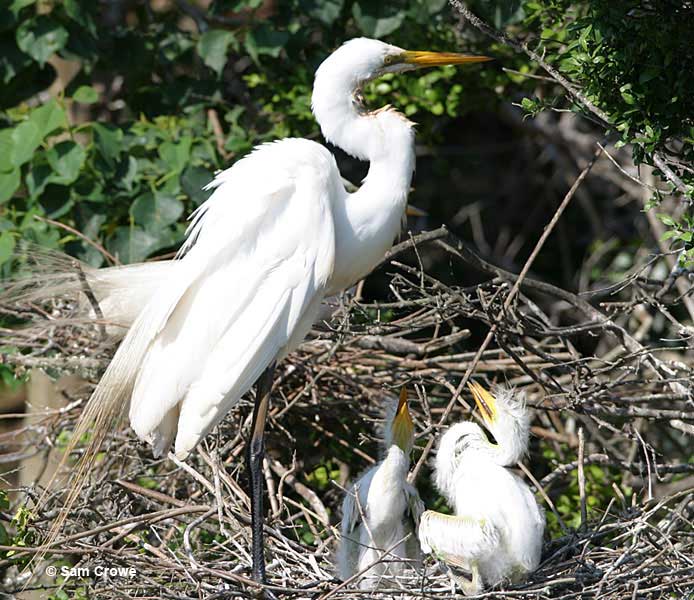
Great Egret nest
As for the eggs, heron family birds may lay three to seven in one clutch. The size of the clutch varies with the climate – birds in temperate zones lay more eggs than their tropical counterparts. Most heron and egret eggs are shiny blue or white.
Egret vs Heron – Frequently Asked Questions
What is the difference between a heron and an egret?
In scientific terms, there is no clear difference – the distinction is mostly linguistic. Simply, we call some members of the heron family ‘herons’ and others ‘egrets.’ Also, the terms are sometimes used interchangeably or change over time for the same bird species. For example, the Great Egret was also known as the Great White Heron.
However, if you really want to know some concrete differences or simply the logic behind naming, let’s give it a go.
- Herons are usually larger than egrets – the largest species of the family are ‘herons.’
- Egrets were originally named for the male’s elongated breeding plumage; however, some herons also have these feathers.
- There are more white ‘egret’ species than white herons.
However, there are many rule-benders in the family. Kenn Kaufman listed some for the Audubon Magazine.
- The Great Egret is more closely related to the Great Blue Heron than other “egrets.”
- The Western Reef Heron is closely related to the Little Egret.
- The Snowy Egret and Reddish Egret share the genus with the Little Blue Heron and Tricolored Heron, meaning they’re also closely related.
Are egrets and herons related?
Both egrets and herons belong to Ardeidae, a 70-species strong family consisting of herons, egrets, and bitterns. That means egrets and herons are in the same family and thus strongly evolutionarily related. In fact, there is barely any difference between them – except for the fact that we’re used to calling some species of the family egrets and others herons.
Do egrets mate with herons?
One of the pillars of the classic species definition is that members of the same species exclusively mate with one another – no getting naughty on the side with members of other species. However, there are cases where individuals of certain species breed with related species – this is called hybridization.
Birds often hybridize. Perhaps surprisingly, there are many cases of hybridization in the egret-heron world. Here are some examples.
- In Japan, researchers recorded and described a hybridization event between a male Little Egret and a female Chinese Pond Heron. This is an interesting one because the birds belong to entirely different genera.
- In South Dakota, ornithologists have been recording hybrid herons ever since the 1950s. In 1996, they reported the interbreeding of a Tricolored Heron and a Snowy Egret.
- In India, there is a possibility that birds thought to be dark morphs of Little Egret could instead be hybrids of the said species and the Indian Reef Heron.
There are even more examples of interspecies and intergeneric heron hybrids – it’s a wild world out there.
Conclusion
In the world of birding, there are probably two clans. The first would find that those linguistic, cultural, and biological dilemmas on egrets, herons, and their “differences” add extra excitement to the hobby and make an interesting conversation starter. The second one is annoyed by it all and would like to stick to the objective scientific classification and Latin names.
However, everyone can agree on one thing. Both egrets and herons are fascinating birds – gorgeous, intelligent, and so fabulous to observe.

